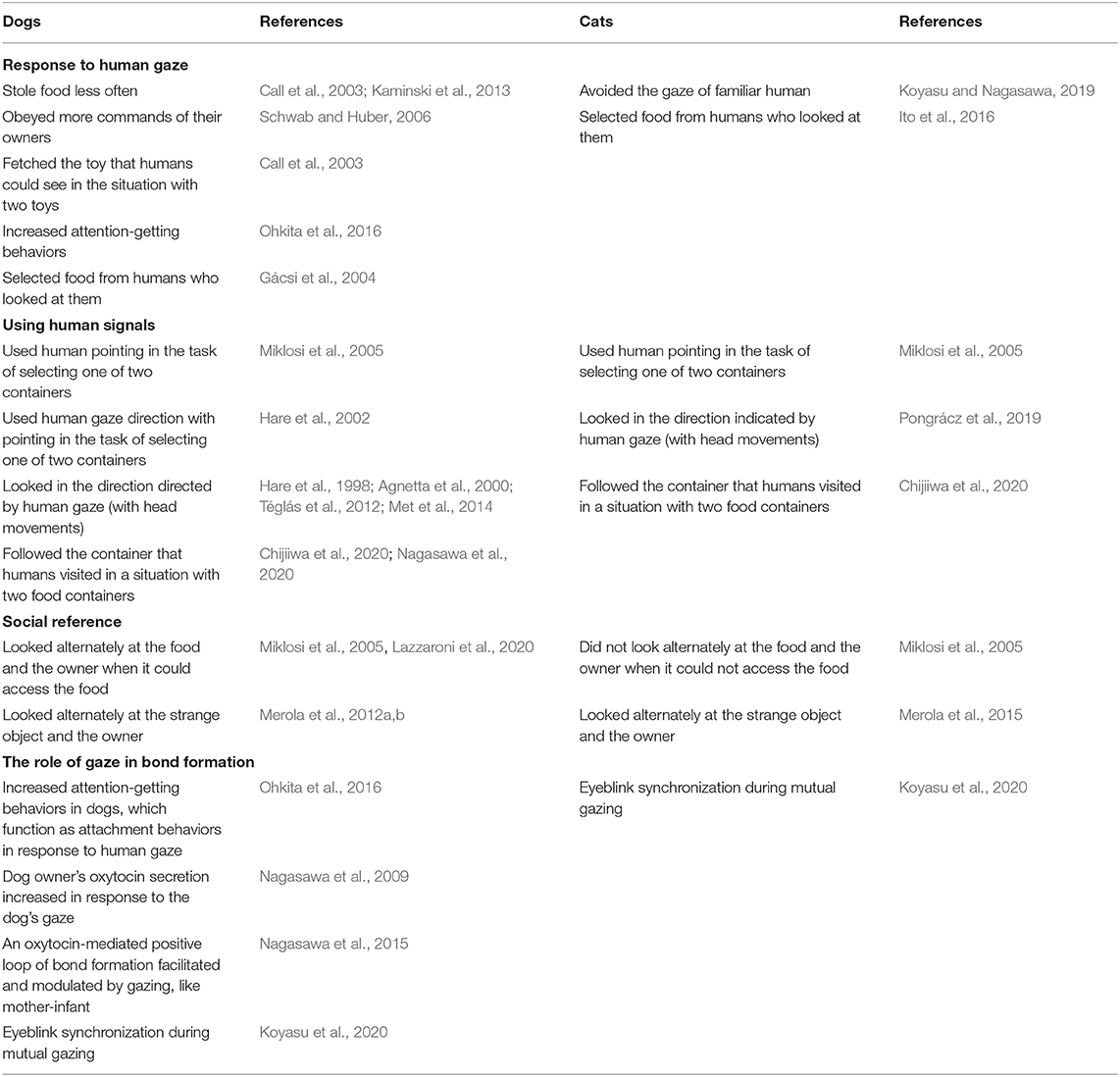The Gaze Communications Between Dogs/Cats and Humans: Recent Research Review and Future Directions
- 1Laboratory of Human-Animal Interaction and Reciprocity, Azabu University, Kanagawa, Japan
- 2Japan Society for the Promotion of Science, Tokyo, Japan
A Corrigendum on
The Gaze Communications Between Dogs/Cats and Humans: Recent Research Review and Future Directions
by Koyasu, H., Kikusui, T., Takagi, S., and Nagasawa, M. (2020). Front. Psychol. 11:613512. doi: 10.3389/fpsyg.2020.613512
In the original article, there was a mistake in Table 1 as published. The references for the entry “Looked alternately at the food and the owner when it could access the food” (section “social reference”) were incorrect. The corrected Table 1 appears below.
The authors apologize for this error and state that this does not change the scientific conclusions of the article in any way. The original article has been updated.
References
Agnetta, B., Hare, B., and Tomasello, M. (2000). Cues to food location that domestic dogs (Canis familiaris) of different ages do and do not use. Anim. Cogn. 3, 107–112. doi: 10.1007/s100710000070
Call, J., Bräuer, J., Kaminski, J., and Tomasello, M. (2003). Domestic dogs (Canis familiaris) are sensitive to the attentional state of humans. J. Comp. Psychol. 117:257. doi: 10.1037/0735-7036.117.3.257
Chijiiwa, H., Takagi, S., Arahori, M., Hori, Y., Saito, A., and Kuroshima, H. (2020). Dogs and cats prioritize human action: choosing a now-empty instead of a still-baited container. Anim. Cogn. doi: 10.1007/s10071-020-01416-w [Epub ahead of print].
Gácsi, M., Miklósi, A., Varga, O., Topál, J., and Csányi, V. (2004). Are readers of our face readers of our minds? Dogs (Canis familiaris) show situation-dependent recognition of human's attention. Anim. Cogn. 7:144. doi: 10.1007/s10071-003-0205-8
Hare, B., Brown, M., Williamson, C., and Tomasello, M. (2002). The domestication of social cognition in dogs. Science 298, 1634–1636. doi: 10.1126/science.1072702
Hare, B., Call, J., and Tomasello, M. (1998). Communication of food location between human and dog (Canis familiaris). Evol. Commun. 2, 137–159. doi: 10.1075/eoc.2.1.06har
Ito, Y., Watanabe, A., Takagi, S., Arahori, M., and Saito, A. (2016). Cats beg for food from the human who looks at and calls to them: ability to understand humans'attentional states. Psychologia 59, 112–120. doi: 10.2117/psysoc.2016.112
Kaminski, J., Pitsch, A., and Tomasello, M. (2013). Dogs steal in the dark. Anim. Cogn. 16:385. doi: 10.1007/s10071-012-0579-6
Koyasu, H., Goto, R., Takagi, S., Nakano, T., Nagasawa, M., and Kikusui, T. (2020). Mutual synchronization of eyeblinks between dogs/cats and humans, in Proceedings of the 80th Annual Meeting of the Japanese Society for Animal Psychology, Suita.
Koyasu, H., and Nagasawa, M. (2019). Recognition of directed-gaze from humans in cats. Jpn. J. Anim. Psychol. 69, 2–3.
Lazzaroni, M., Marshall-Pescini, S., Manzenreiter, H., Gosch, S., Pøibilová, L., and Darc, L. (2020). Why do dogs look back at the human in an impossible task? Looking back behaviour may be over-interpreted. Anim. Cogn. 23:427. doi: 10.1007/s10071-020-01345-8
Merola, I., Lazzaroni, M., Marshall-Pescini, S., and Prato-Previde, E. (2015). Social referencing and cat-human communication. Anim. Cogn. 18, 639–648. doi: 10.1007/s10071-014-0832-2
Merola, I., Prato-Previde, E., and Marshall-Pescini, S. (2012a). Dogs' social referencing towards owners and strangers. PLoS One 7:e47653. doi: 10.1371/journal.pone.0047653
Merola, I., Prato-Previde, E., and Marshall-Pescini, S. (2012b). Social referencing in dog-owner dyads? Anim. Cogn. 15, 175–185. doi: 10.1007/s10071-011-0443-0
Met, A., Miklósi, Á, and Lakatos, G. (2014). Gaze-following behind barriers in domestic dogs. Anim. Cogn. 17:1401. doi: 10.1007/s10071-014-0754-z
Miklosi, A., Pongracz, P., Lakatos, G., Topal, J., and Csanyi, V. (2005). A comparative study of the use of visual communicative signals in interactions between dogs (Canis familiaris) and humans and cats (Felis catus) and humans. J. Comp. Psychol. 119, 179–186. doi: 10.1037/0735-7036.119.2.179
Nagasawa, M., Kikusui, T., Onaka, T., and Ohta, M. (2009). Dog's gaze at its owner increases owner's urinary oxytocin during social interaction. Horm. Behav. 55, 434–441. doi: 10.1016/j.yhbeh.2008.12.002
Nagasawa, M., Mitsui, S., En, S., Ohtani, N., Ohta, M., and Sakuma, Y. (2015). Oxytocin-gaze positive loop and the coevolution of human-dog bonds. Science 348, 333–336. doi: 10.1126/science.1261022
Nagasawa, M., Mogi, K., Ohtsuki, H., and Kikusui, T. (2020). Familiarity with humans affect dogs' tendencies to follow human majority groups. Sci. Rep. 10:7119.
Ohkita, M., Nagasawa, M., Kazutaka, M., and Kikusui, T. (2016). Owners' direct gazes increase dogs' attention-getting behaviors. Behav. Process. 125:96. doi: 10.1016/j.beproc.2016.02.013
Pongrácz, P., Szapu, J. S., and Faragó, T. (2019). Cats (Felis silvestris catus) read human gaze for referential information. Intelligence 74, 43–52. doi: 10.1016/j.intell.2018.11.001
Schwab, C., and Huber, L. (2006). Obey or not obey? Dogs (Canis familiaris) behave differently in response to attentional states of their owners. J. Comp. Psychol. 120:169.
Keywords: dogs, cats, humans, gaze, interaction, communication, bond
Citation: Koyasu H, Kikusui T, Takagi S and Nagasawa M (2021) Corrigendum: The Gaze Communications Between Dogs/Cats and Humans: Recent Research Review and Future Directions. Front. Psychol. 12:645366. doi: 10.3389/fpsyg.2021.645366
Received: 23 December 2020; Accepted: 04 February 2021;
Published: 01 March 2021.
Edited and reviewed by: Christian Nawroth, Leibniz Institute for Farm Animal Biology (FBN), Germany
Copyright © 2021 Koyasu, Kikusui, Takagi and Nagasawa. This is an open-access article distributed under the terms of the Creative Commons Attribution License (CC BY). The use, distribution or reproduction in other forums is permitted, provided the original author(s) and the copyright owner(s) are credited and that the original publication in this journal is cited, in accordance with accepted academic practice. No use, distribution or reproduction is permitted which does not comply with these terms.
*Correspondence: Miho Nagasawa, nagasawa@carazabu.com
 Hikari Koyasu
Hikari Koyasu Takefumi Kikusui
Takefumi Kikusui Saho Takagi1,2
Saho Takagi1,2 Miho Nagasawa
Miho Nagasawa